Clash of Titans
Games featuring a future Hall of Fame coach on each sideline.
November 12, 1955: Texas A&M @ Rice
Bear Bryant vs Jess Neely
After just one 6-2-1 season as head coach at Maryland in 1945, 32-year-old Paul "Bear" Bryant was hired by the University of Kentucky. He faced a formidable challenge in Lexington.
Since beginning football in 1915, the Wildcats had yet to win a championship in the sport. In the Southeastern Conference, which broke off from the Southern Conference in 1933, UK had never had a winning record in conference play. The World War II years were especially cruel: just 1-19 in SEC play and 13-24-1 overall.
While the Wildcats were doormats on the gridiron, they were the SEC powerhouse in basketball, winning ten regular season titles and finishing second the other four years under Coach Adolph Rupp.
Bryant immediately turned the Wildcats into winners: 7-3 in '46, 9-2 in '47 including UK's first bowl win, and 5-3-2 in '48. Kentucky went 10-2 and 11-1 the next two seasons, losing in the Orange Bowl after the '49 season and upsetting #1 Oklahoma in the Sugar Bowl the following year. But Bear couldn't repeat the double-digit win success in 1951 (8-4 with an Orange Bowl victory) or '52 (5-4-2).
The Wildcats improved to 7-2-1 in '53 to tie for second in the SEC. But Bryant had already begun to look for an opportunity to coach at a school where football was the #1 sport.
Multiple factors influenced his decision to leave. The 1951 basketball point-shaving scandal led to recruiting restrictions not only on the basketball program but other sports as well. Also, it was obvious to Bryant that football would never be king in Lexington as long as Rupp was the basketball coach.
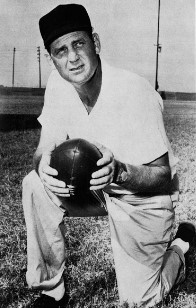
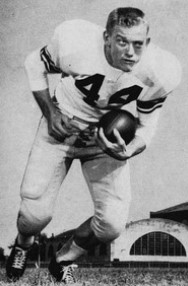
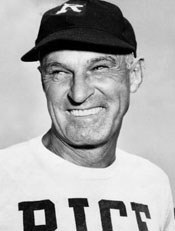
L-R: Bear Bryant, John David Crow, Jess Neely
(Texas A&M University Aggieland Yearbook - Class of 1956)
In an interview with Sports Illustrated in 1966, Bear made these comments. "We won at Kentucky, and I don't think I'd have ever left if I hadn't gotten pigheaded! It was probably the most stupid thing I ever did. I could have had just about anything I wanted, and Mary Harmon [his wife] loved it. … I guess, to be perfectly honest about it, that was the crux of the matter, me and Coach Rupp. If Rupp had retired as basketball coach when they said he was going to, I'd probably still be at Kentucky. The trouble was we were too much alike, and he wanted basketball No. 1, and I wanted football No. 1. In an environment like that, one or the other has to go."
Bear Becomes an Aggie
Where would Bear go? Many colleges came acallin'. He revealed years later that an LSU Board member told him to name his price, and they'd pay it. But he took so long deciding whether to leave Kentucky that the only job open when he made his decision was Texas A&M.
As one of Bear's players his first year at A&M put it, Texas A&M "was a tough place to recruit players, since the Aggies were the cellar team in the Southwest Conference, there were no girls and it was mostly military with compulsory ROTC, including the athletes. It was often referred to as a 'poor boys school' and a 'cow college' and was the brunt of a lot of Aggie jokes."
Bryant's wife, who had loved Lexington KY, turned pale and burst out crying when she got off the plane at College Station TX. Bryant said, "At first glance, Texas A&M looked like a penitentiary. No girls. No glamour. A lifeless community. I was like Mary Harmon. I nearly died when I saw what I was getting into." Bear started calling Texas A&M "Sing-Sing on the Brazos."
Bryant wasn't impressed with the players he inherited. He was in the process of recruiting an outstanding freshman class for 1954, but they couldn't play varsity ball for another year. Feeling that many of his players were weak and not properly trained or coached, he arranged for a camp to be held in the small town of Junction TX, where Texas A&M had a 411-acre adjunct campus.
Amidst a drought and a heat wave throughout the 10 days, many players left after a few days of grueling practices. Two busses filled with players left campus for Junction. Only one bus returned. The 38 survivers formed the nucleus for Bryant's first Texas A&M football squad.
The 1954 Aggies won only one of their ten games, a 6-0 win at Georgia in Game 3. The only blowout was the first game, a 41-9 trouncing from Texas Tech.
With the addition of a fine sophomore class led by RB John David Crow from Springhill LA, the 1955 Aggies lost their opener at UCLA 21-0 before winning five in a row, including a 28-0 whitewash of LSU in Dallas. After a 7-7 tie at Arkansas, A&M beat SMU at home 13-2. That set up a showdown with Rice in Houston.
With a 5-1-1 record, A&M entered the game as a touchdown favorite. On the other hand, Jess Neely's Owls, besieged by injuries, had lost four straight games, causing rumblings among the fans that the veteran coach's days were numbered.
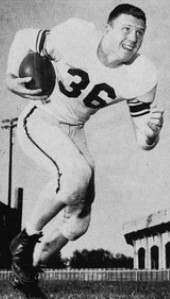
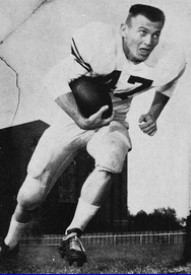
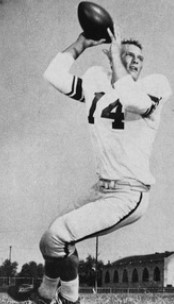
L-R: Jack Pardee, Don Watson, Jimmy Wright
(Texas A&M University Aggieland Yearbook - Class of 1956
Owls Stifle Crow
Neely had his defense focus on stopping Crow, whom Bryant would call "the greatest player I ever coached." The 6'2" 215 pounder was a punishing runner who also backed up the line and played safety in that limited substitution era. The Aggies never threatened during the first three periods as the Owls, stacking nine men at the line of scrimmage, also stopped hard-charging FB/LB Jack Pardee.
Bryant had aided the opponent's task by starting Don Watson, normally a halfback, at quarterback because he was dissatisfied with the play of his other three signal-callers. Don was a quick runner but couldn't pass worth a damn. The closest either team came to scoring in the first three periods was Rice's 56y drive that petering out at the 10.
Rice Scores First
The home team broke the scoring ice in the final period. Taking advantage of a short Aggie punt, QB King Hill completed several passes to put the ball on the seven. From there, Paul Zipperlen carried it across. The PAT kick sailed wide. 6-0 Rice
The Owls were back in business immediately when Bill Dendy fumbled while returning the kickoff and Rice G Lew Harpold fell on the ball at the A&M 31. The Rice backs alternated toting the leather until Zipperlen again did the honors around left end on fourth-and-one from the five. The Aggies blocked the PAT try to keep the score at 12-0 with eight minutes left.
To make matters worse, Crow was carried off the field on A&M's next possession. Since he didn't start the quarter, he couldn't return even if he recovered.
So you couldn't blame the spectators among the 68,000 in Rice Stadium who began leaving with five minutes to go in what had been a boring game. Inept all afternoon, A&M's offense might score one touchdown but two? No way.
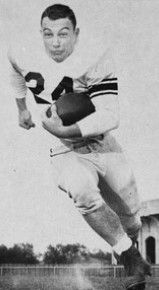
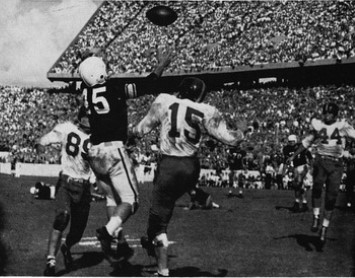
L: Loyd Taylor; R: Paul Zipperlen (15) intercepts first half pass intended for Taylor on Rice 1.
(Texas A&M University Aggieland Yearbook - Class of 1956)
A&M Explodes in Final Minutes
In the press box, Clark Nealon, sports editor of the Houston Post, told his young reporter Mickey Herskowitz to head down to the A&M dressing room for the post-game interview. The only writer who went with Bear's maiden Aggie squad to Junction TX for the brutal preseason practices of 1954, Mickey didn't relish facing Bryant after the loss. "He's very superstitious, and he'll blame that big story I did on him this morning for getting beat. He'll chew me out for jinxing him."
As Mickey waited for the cumbersome elevator to arrive, he heard a loud roar from the crowd. He assumed Rice had recovered a fumble. As the elevator ponderously descended, the passengers heard another roar. "Guess Rice scored," thought Herskowitz.
When the lift finally reached ground level, Mickey elbowed his way through the standing spectators to get to the field. Just as he came in view of the action, Watson scored a touchdown for A&M. "Well, the Aggies at least scored." Then Mickey glanced at the scoreboard, and his jaw dropped: A&M 20 Rice 12
By the time the writer battled his way into the jubilant A&M dressing room, Bear was sitting on the steps, his head buried in his arms.
"Coach, I got caught in the elevator. What in the world happened?"
"I don't know. I was too busy praying."
The Aggies had pulled victory from the jaws of defeat by scoring three touchdowns in the space of two minutes and 18 seconds.
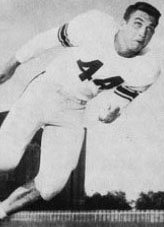
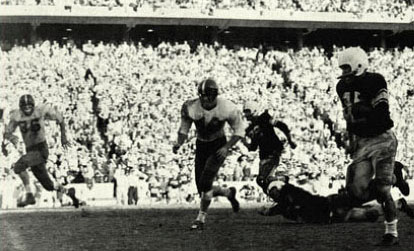
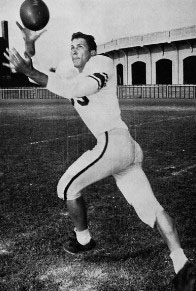
L-R: Bobby Keith; Taylor on his 58y jaunt to the Rice 3 in the fourth quarter; Gene Stallings.
(Texas A&M University Aggieland Yearbook - Class of 1956)
First, A&M finally scored with 3:18 left. Desperate to shake up his offense, Bryant inserted Jimmy Wright at quarterback with 4:31 to play. Wright had gotten into Bear's doghouse by passing too much.
Still, it was a run that finally got the Aggies going. Speedy sophomore HB Loyd Taylor, playing in Crow's absence, took an option pitchout from Wright and set sail around left end. Ends Bobby Keith and Gene Stallings took out the nearest defenders to allow Taylor to streak down the sideline until HB Ken Williams lassoed him at the three. Carries by Pardee and Wright failed to penetrate the Owl defense. So Taylor took over again and slanted off left tackle into the end zone. He also booted the extra point to make it 12-7 Rice.
Everyone still in the stadium knew what was coming next. Neely gathered his kick return team on the sidelines and warned them to watch for an onside kick. Jack Powell's kick spiraled toward the left sideline. With the widest Owl too far inside, Bear's favorite player, Stallings, beat everyone to the ball on the Rice 43.
Fearing that the Watson experiment might not work, Bear had told Wright before the opening kickoff, "If we get behind, you're goin' in. I want you to throw it deep. Keep an eye on number 15 [Zipperlin]. He's a sucker for the long pass."
So Jimmy called a play that required Taylor to go deep. "I ain't worked on it," said Loyd. But Wright assured him: "All you gotta do is run past number 15. I'll throw it to the flag. Just make sure you get there."
The play worked like a charm. Loyd roared past Zipperlin and caught Wright's pass just as he entered the end zone. Taylor added the PAT for his 14th point in 46 seconds. Just like that, Texas A&M led 14-12.
Suddenly and shockingly behind with a little more than two minutes to play, Rice took to the air. But Hill fired the ball right to Pardee. Jack rambled down the sideline for 40y to the eight.
After Rice was penalized to the three, Watson, able to return to the game since he started the period, followed Pardee's block into the end zone to complete the stunning comeback. This was the play that Herskowitz had thought was A&M's first score.
Three touchdowns in 2:16 – the fastest comeback in college football history. 20 points in only four snaps.
Postgame
Needless to say, the two dressing rooms provided a contrast in moods.
The exultant Aggies doused Wright with Cokes. But it would take more than one touchdown pass for Bryant to trust him. That's why he had put Watson back in after getting the lead.
Bear told the press, "We were lucky to win it. They outplayed us for three quarters. But I'm lucky to be coaching a bunch like this, and I'm not surprised at anything they do."
A&M President Dr. David Morgan was one of the first to congratulate his coach. "I don't believe it, Coach. Tell me it's true." Bryant replied, "I don't believe it either."
Bear admitted he had tried to take Taylor out of the game after his 55y run. "I knew he was tired. I wanted to put Bobby Conrad in, but I couldn't get him in. Maybe I was lucky."
Taylor, lisping through two missing front teeth, said, "It was nothing. All I had to do was run hard."
The usually impassive Neely wore an obvious pained look in the somber Rice locker room. "It's hard to understand. We knew the only way on earth they could beat us, even after that first touchdown, was to try an onside kick. ... There was no sense to it, playing so well for all that time, then doing so badly in the last few minutes."
The victory gave the Aggies a shot at their first Southwest Conference since 1939 by defeating Texas in their final game. But even if they won, they couldn't represent the Southwest Conference in a bowl game because they had been put on probation by the conference and the NCAA for recruiting violations.
That factor became a moot point when A&M once again lost to the Longhorns 21-6. Bryant still had a ways to go to bring the Aggies back to football prominence.
References:
http://www.bigbluehistory.net/bb/bearbryant.html
The Greatest Moments in the Southwest Conference, Will Grimsley (1968)
The Junction Boys: How Ten Days in Hell Forged a Championship Team, Jim Dent (1999)
Backyard Brawl: Inside the Blood Feud between Texas and Texas A&M, W.K. Stratton (2002)
Bebes and the Bear: Gene Stallings, Coach Bryant, and Their 1968 Cotton Bowl Showdown, Ron J. Jackson Jr. (2019)
http://www.bigbluehistory.net/bb/bearbryant.html
The Greatest Moments in the Southwest Conference, Will Grimsley (1968)
The Junction Boys: How Ten Days in Hell Forged a Championship Team, Jim Dent (1999)
Backyard Brawl: Inside the Blood Feud between Texas and Texas A&M, W.K. Stratton (2002)
Bebes and the Bear: Gene Stallings, Coach Bryant, and Their 1968 Cotton Bowl Showdown, Ron J. Jackson Jr. (2019)